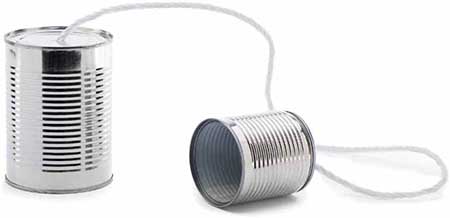Two Tin Cans and a String: The Internet Begins

Pop Quiz: How many devices do you own that can go online anytime and anywhere? You know the right answer, but the point is that our norm in 2015 was at best a dream in the early days of the Internet.
For its tenth anniversary, Technology & Learning offered predictions for the future, stating, “In the 90’s schools will look to technology more than ever before for educational solutions.” TERC’s director, Dr. Robert Tinker, predicted the development of an international telecommunications network for K-12 education by 1995. And digital video with the ability to send full-motion video over a network was another wish.
The early Internet—The Information Superhighway—was a network of networks that linked mostly academic and government networks to carry information and services such as electronic mail, online chat, and file transfer. Only later would it include pages hyperlinked on the World Wide Web.
Email started in 1965 as a way for time-sharing mainframe users to communicate, and became popular on personal computers in the mid-1980’s. In 1986 Classroom Computer Learning (Tech & Learning’s former name) identified the Internet’s top three uses as email, teleconferencing, and databases. Online research meant using Boolean searching, access with FTP (file transfer protocol), and programs like Gopher, Telnet and Fetch. Popular, too, were discussion forums and message boards.
The Internet looked very different in those days. There were no Smartphones to tap a few keys on—or speak instructions to—and connect with the world. You used dial-up services like America Online and CompuServe and an acoustic coupler—a hardware device that enabled a modem (a device to convert signals from analog to digital and from digital back to analog) to connect to a voice circuit. You put a telephone receiver into the coupler and waited for the telltale squawk.
The NYC school system developed its own dial-up service called Nycenet. As a high school teacher/computer coordinator in the late 1980’s, I used a 300-baud acoustic coupler, a telephone line, and my Nycenet chat account so students could participate in a project to communicate with celebrities in real time. For example, when Jets’ wide receiver Wesley Walker was online, I typed in the students’ questions and read Walker’s answers aloud from my computer screen.
The National Science Foundation and the US Department of Education funded sophisticated telecommunications projects. Dr. Robert Tinker called the work “network science.”
Tools and ideas to transform education. Sign up below.
As today, information was king. To search online databases, you used keywords with Boolean operators such as AND, NOT and OR to produce relevant results. For example, a Boolean search could be “education” AND “technology.” This would limit the search results to documents containing both keywords.
Education had its own databases. As early as 1987, information service providers such as CompuServe and The Source provided databases for educators and students. And major companies such as Dialog, Addison-Wesley, and McGraw-Hill offered information and classroom application packages.
For example, in 1987, students had pen pals in other countries, peer-edited across the US, joined a network conference remotely, and asked questions of experts using the McGraw-Hill Information Exchange (MIX). Educators could discuss ideas with peers in far-off places in electronic teachers’ lounges.
Even the Educational Resources Information Center (ERIC), which began in 1966 with funding from the US Dept of Education, went online. Educators used a modem, telecommunications software, and a database vendor such as BRS or Dialog to access ERIC’s databases of abstracts. In 1992, they created the AskERIC Virtual Library, a source of lesson plans and entry into the rest of ERIC.
By 1995, T&L initiated its first telecommunications column, The Online Connection. Contributing editor Odvard Egil Dyrli wrote about online content area indexes. He said, “…the Internet is unbelievably huge (a network of 40,000 smaller networks)” and “…it is easy to get lost or discouraged.”
The Web became more available to schools in the late 1990s—thanks to the federal E-rate program—and a new era in teaching and learning began.
Gwen Solomon was senior analyst at the US Dept of Education, Director of the Well Connected Educator, and is the author of several books on edtech, including Web 2.0: how to for educators. She has been a contributing editor for Tech & Learning since 1998.
Gwen Solomon was Founding Director of The School of the Future in New York City, Coordinator of Instructional Technology Planning for New York City Public Schools, and Senior Analyst in the U.S. Department of Education’s Office of Instructional Technology. She has written and co-authored several books and many magazine articles on educational technology.
